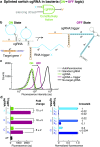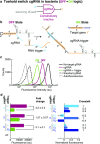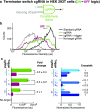Conditional Guide RNAs: Programmable Conditional Regulation of CRISPR/Cas Function in Bacterial and Mammalian Cells via Dynamic RNA Nanotechnology
- PMID: 31403072
- PMCID: PMC6661866
- DOI: 10.1021/acscentsci.9b00340
Conditional Guide RNAs: Programmable Conditional Regulation of CRISPR/Cas Function in Bacterial and Mammalian Cells via Dynamic RNA Nanotechnology
Abstract
A guide RNA (gRNA) directs the function of a CRISPR protein effector to a target gene of choice, providing a versatile programmable platform for engineering diverse modes of synthetic regulation (edit, silence, induce, bind). However, the fact that gRNAs are constitutively active places limitations on the ability to confine gRNA activity to a desired location and time. To achieve programmable control over the scope of gRNA activity, here we apply principles from dynamic RNA nanotechnology to engineer conditional guide RNAs (cgRNAs) whose activity is dependent on the presence or absence of an RNA trigger. These cgRNAs are programmable at two levels, with the trigger-binding sequence controlling the scope of the effector activity and the target-binding sequence determining the subject of the effector activity. We demonstrate molecular mechanisms for both constitutively active cgRNAs that are conditionally inactivated by an RNA trigger (ON → OFF logic) and constitutively inactive cgRNAs that are conditionally activated by an RNA trigger (OFF → ON logic). For each mechanism, automated sequence design is performed using the reaction pathway designer within NUPACK to design an orthogonal library of three cgRNAs that respond to different RNA triggers. In E. coli expressing cgRNAs, triggers, and silencing dCas9 as the protein effector, we observe a median conditional response of ≈4-fold for an ON → OFF "terminator switch" mechanism, ≈15-fold for an ON → OFF "splinted switch" mechanism, and ≈3-fold for an OFF → ON "toehold switch" mechanism; the median crosstalk within each cgRNA/trigger library is <2%, ≈2%, and ≈20% for the three mechanisms. To test the portability of cgRNA mechanisms prototyped in bacteria to mammalian cells, as well as to test generalizability to different effector functions, we implemented the terminator switch in HEK 293T cells expressing inducing dCas9 as the protein effector, observing a median ON → OFF conditional response of ≈4-fold with median crosstalk of ≈30% for three orthogonal cgRNA/trigger pairs. By providing programmable control over both the scope and target of protein effector function, cgRNA regulators offer a promising platform for synthetic biology.
Conflict of interest statement
The authors declare the following competing financial interest(s): Filed patents.
Figures






Similar articles
-
High-Performance Allosteric Conditional Guide RNAs for Mammalian Cell-Selective Regulation of CRISPR/Cas.ACS Synth Biol. 2021 May 21;10(5):964-971. doi: 10.1021/acssynbio.1c00037. Epub 2021 Apr 30. ACS Synth Biol. 2021. PMID: 33930275
-
Engineered circular guide RNAs boost CRISPR/Cas12a- and CRISPR/Cas13d-based DNA and RNA editing.Genome Biol. 2023 Jun 23;24(1):145. doi: 10.1186/s13059-023-02992-z. Genome Biol. 2023. PMID: 37353840 Free PMC article.
-
Signal Transduction in Human Cell Lysate via Dynamic RNA Nanotechnology.ACS Synth Biol. 2018 Dec 21;7(12):2796-2802. doi: 10.1021/acssynbio.8b00424. Epub 2018 Dec 7. ACS Synth Biol. 2018. PMID: 30525469 Free PMC article.
-
Harnessing CRISPR/Cas systems for programmable transcriptional and post-transcriptional regulation.Biotechnol Adv. 2018 Jan-Feb;36(1):295-310. doi: 10.1016/j.biotechadv.2017.11.008. Epub 2017 Nov 29. Biotechnol Adv. 2018. PMID: 29197619 Review.
-
CRISPR/Cas9-based epigenome editing: An overview of dCas9-based tools with special emphasis on off-target activity.Methods. 2019 Jul 15;164-165:109-119. doi: 10.1016/j.ymeth.2019.05.003. Epub 2019 May 6. Methods. 2019. PMID: 31071448 Review.
Cited by
-
Dynamic RNA Nanotechnology Enters the CRISPR Toolbox.ACS Cent Sci. 2019 Jul 24;5(7):1111-1113. doi: 10.1021/acscentsci.9b00550. Epub 2019 Jun 18. ACS Cent Sci. 2019. PMID: 31404241 Free PMC article. No abstract available.
-
Controlling and enhancing CRISPR systems.Nat Chem Biol. 2021 Jan;17(1):10-19. doi: 10.1038/s41589-020-00700-7. Epub 2020 Dec 16. Nat Chem Biol. 2021. PMID: 33328654 Free PMC article. Review.
-
Precise and Programmable Detection of Mutations Using Ultraspecific Riboregulators.Cell. 2020 Mar 5;180(5):1018-1032.e16. doi: 10.1016/j.cell.2020.02.011. Epub 2020 Feb 27. Cell. 2020. PMID: 32109416 Free PMC article.
-
A kinetically controlled platform for ligand-oligonucleotide transduction.Nat Commun. 2021 Aug 2;12(1):4654. doi: 10.1038/s41467-021-24962-4. Nat Commun. 2021. PMID: 34341342 Free PMC article.
-
Utilizing RNA origami scaffolds in Saccharomyces cerevisiae for dCas9-mediated transcriptional control.Nucleic Acids Res. 2022 Jul 8;50(12):7176-7187. doi: 10.1093/nar/gkac470. Nucleic Acids Res. 2022. PMID: 35648481 Free PMC article.
References
-
- Gilbert L. A.; Larson M. H.; Morsut L.; Liu Z.; Brar G. A.; Torres S. E.; Stern-Ginossar N.; Brandman O.; Whitehead E. H.; Doudna J. A.; Lim W. A.; Weissman J. S.; Qi L. S. CRISPR-mediated modular RNA-guided regulation of transcription in eukaryotes. Cell 2013, 154, 442–451. 10.1016/j.cell.2013.06.044. - DOI - PMC - PubMed
LinkOut - more resources
Full Text Sources
Other Literature Sources
Miscellaneous

